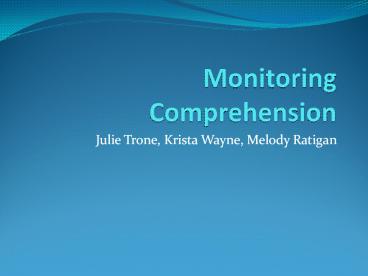Monitoring Comprehension - PowerPoint PPT Presentation
1 / 19
Title:
Monitoring Comprehension
Description:
Monitoring Questioning Connencting Reacting Inferring Inferring The Inner Conversation The voice you hear ... our students to be ACTIVE readers not PASSIVE ... – PowerPoint PPT presentation
Number of Views:127
Avg rating:3.0/5.0
Title: Monitoring Comprehension
1
Monitoring Comprehension
- Julie Trone, Krista Wayne, Melody Ratigan
2
Reading
- Define Reading to your partner
- Reading Getting the meaning of something
written by using the eyes to interpret its
characters. - Websters New World Dictionary (1991)
3
Comprehension
- Goal- CONSTRUCT MEANING
- Teachers are too often assessing rather than
teaching our students to better comprehend what
they read. - Comprehension strategies are to help students
construct meaning from text.
4
How do you construct meaning from text?
- Monitor Understanding
- Enhance Understanding
- Acquire and Actively Use Knowledge
- Develop Insight
5
Strategies to use to Construct Meaning from text
- Connections- prior knowledge and new information
- Ask Questions
- Draw Inferences during and after reading
- Separate important from less important ideas in
text - Combine information within and across texts and
reading experiences - Monitor the adequacy of their understanding and
repair faulty comprehension
6
Purpose for Reading
- There is always one purpose for sure and that is
understanding - Teach kids to think about their purpose for
reading - WHY?
- Proficient readers adapt strategies for their
purpose for reading - You need metacognitive knowledge to match the
strategies to your purpose for reading
7
Reciprocal Teaching
- A teacher student dialogue where teacher models
and gradually relinquishes control to the
student. - Based on Vygotskys zone of proximal development.
- Teacher provides instructional scaffold
- This sentence by sentence guidance is more
appropriate for readers with severe reading and
language problems.
8
Reciprocal Teaching
- Why It Works
- 1. By having the teacher engage explicitly in
comprehension monitoring, it provides a model for
the novice reader of what expert readers do when
they try to learn from texts. - 2. It obligates even the quietest of students to
respond openly, thus allowing teachers to assess
students current level and provide appropriate
feedback.
9
Metacognitive Knowledge
- An awareness and understanding of how one thinks
and uses strategies during reading. - Four aspects of metacognitive knowledge- These
help understand how learners adapt strategies to
their purposes.
10
Four Aspects of Metacognitive Knowledge
- Tacit Learners/Readers- lack an awareness of how
they think while reading - Aware Learners/Readers- Realize when meaning
breaks down, but do not know enough fix-up
strategies - Strategic Learners/ Readers- Use their thinking
and comprehension as tools, but are unable to
monitor and repair meaning with it is disrupted. - Reflective Learners/ Readers- Stratgic thinkers,
apply strategies flexibly based off goals and
purpose, and monitor thinking and understanding.
Also reflect, ponder and revise their use of
strategies.
11
Monitoring
Questioning
Connencting
Reacting
Inferring
Inferring
12
The Inner ConversationThe voice you hear when
you read silently is not silent, it is a speaking
out-loud voice in your head. Thomas Lux
- Voice in head while reading that allows to
construct meaning - You have to have an inner conversation to know
when you stray from it - Awareness quicker repair when meaning breaks
down - Teach readers to stay on top of their reading
- Readers move toward independence when they can
monitor their comprehension
13
Inner Conversation Cont.
- We teach readers to
- Become aware of their thinking during reading
- Monitor understanding and keep track of meaning
- Listen to the voice in their head to construct
meaning - Notice when they stray from thinking about text
- Notice when meaning breaks down
- Detect obstacles and confustions that detail
understanding - Understand how numerous strategies can help
repair meaning - Know when, why, and how to apply certain
strategies to keep and continue understanding
14
Krista
- Following the inner conversation
- Purpose Listen to the inner voice and leave
tracks of thinking (Sticky Notes) - Interactive Reading aloud- reading aloud for the
purpose of instruction - Steps
- Activate background knowledge
- Model
- Guided practice
- Sharing thinking
15
Krista
- Noticing When we stray from the Inner
Conversation - Purpose Monitoring the inner voice to focus
thinking and fix- up comprehension
16
Melody
- Noticing and exploring thinking
- Purpose Listening to the inner voice and
responding to the text - Steps
- Talk about my own personal connection to story.
- Read book all the way through without stopping.
- Ask students to write down their inner
conversation on a large sticky note. - Share with a partner.
- Collect sticky notes and put them on anchor
chart.
17
Melody
- Knowing when you know and knowing when you dont
know - Purpose Monitoring comprehension to clarify
confusion or answer questions about the text - Materials Sticky notes coded Huh? for confused
and with a light bulb for readers illumination.
18
Julie
- Read, Write, and Talk
- Purpose Teaching readers to stop, think, and
react to informational text
19
Monitoring Comprehension Review
- Engagement
- Teach our students to be ACTIVE readers not
PASSIVE































